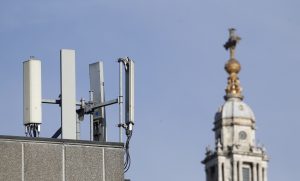Editor’s Note: The following is a preview of the latest edition of the APAC Risk Newsletter, presented by Diplomat Risk Intelligence. To read the full newsletter, click here to subscribe for free.
In late January, the government of the United Kingdom announced that it had reached a decision on allowing Chinese technology company Huawei to provide infrastructure for what will be a national 5G network. The UK decision came amid intense pressure from the United States to disallow Huawei, which the U.S. intelligence community has described as a backdoor for Chinese intelligence; in 2018, several high-level U.S. intelligence officials said Huawei products could be used by China to conduct “undetected espionage.”
American pressure on London had been coming from the highest levels of government. On Thursday, the Financial Times exclusively reported on a phone call between U.S. President Donald J. Trump and Johnson.
Trump lambasted Johnson for the decision to allow Huawei in, suggesting that U.S. pressure tactics—even against the country’s closest allies—are only set to intensify. Similar pressure exists on U.S. allies in the Asia-Pacific region. At the recent Raisina Dialogue in New Delhi, India, Matt Pottinger, the U.S. deputy national security adviser, suggested that allowing Huawei into critical telecommunications networks was akin to allowing the KGB to provide similar products during the Cold War: “Can you imagine [Ronald] Reagan and [Margaret] Thatcher having a conversation in the 1980s saying, ‘Let’s have the KGB build our telecommunications systems, because they’re giving us a great discount,’” Pottinger said.
One of the best reads on the potential security risks emerging from Huawei’s involvement in the UK’s 5G implementation comes from Simeon Gilding over at the Australian Strategy Policy Institute. Gilding, a former signals intelligence practitioner in Australia, outlines why he sees the technical justifications proffered by British policymakers as insufficient—specifically why the so-called “core-edge” distinction is not really a robust means to protect sensitive networks:
Geography is not a factor in how core–edge works. The reality is mature 5G networks actually require the collapse of the core–edge distinction. 5G can only reach its potential for speed and low latency if sensitive functions can happen at the edge of the network close to the customer. And 5G can only realise its cost-saving potential if any function can occur at the most efficient place in the network, wherever that is. In mature 5G networks, sensitive data and functions will be distributed throughout the network in a dynamic way which will be impossible to govern with certainty.
Sure, many telcos (including in Australia) are already operating networks branded as ‘5G’, on the basis that they deploy new, more efficient 5G radios at the edge of the network. But the hyperconnected, transformational 5G future marketed by the telcos can only be realised if there is no distinction between core and edge.
The public debate on Huawei, naturally, is not replete with SIGINT veterans, leaving several arguments either coming off as over-hyped or dangerously naive. What’s most interesting in Gilding’s discussion, however, is what he implies, for instance, Australian SIGINT might be able to pull off with access to the data of a 5G provider (as Chinese intelligence might have in the case of Huawei): “We concluded that we could be awesome, no one would know and, if they did, we could plausibly deny our activities, safe in the knowledge that it would be too late to reverse billions of dollars’ worth of investment. And, ironically, our targets would be paying to build a platform for our own signals intelligence and offensive cyber operations.”
After the UK’s decision, the debate on 5G risks continues across the English channel in Europe, where concerns about risk mitigation loom large (albeit not evenly across all countries).
Bottom Line: The debate over the UK’s decision to allow Huawei to participate in the construction of 5G infrastructure is far from over, but London’s decision likely captures the decision-making process that several other countries will go through in the coming months and years.
Go Deeper: On the Asia Geopolitics podcast, Prashanth Parameswaran and I had a wide-ranging conversation about 5G technology, telecommunications infrastructure, vulnerabilities, and risk mitigation strategies in the context of Huawei. Have a listen and subscribe here. (If you’re an iOS or Mac user, you can also subscribe to The Diplomat’s Asia Geopolitics podcast on iTunes here; if you use Windows or Android, you can subscribe on Google Play here, or on Spotify here.)
To read the entirety of the latest edition of the APAC Risk Newsletter, presented by Diplomat Risk Intelligence, click here to subscribe for free.

































